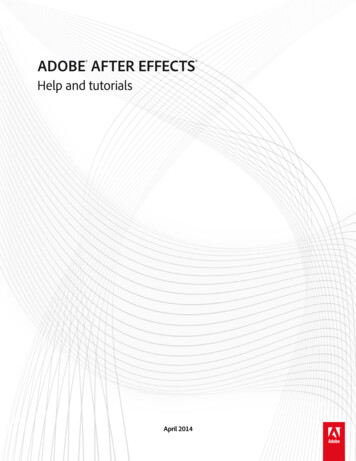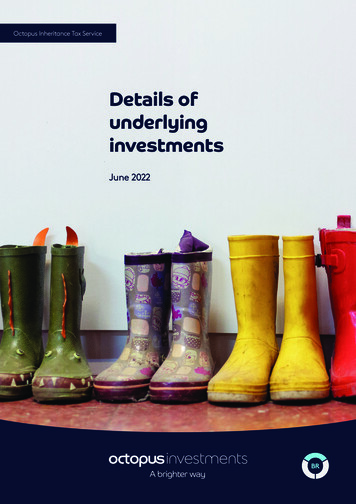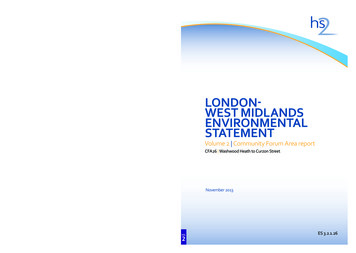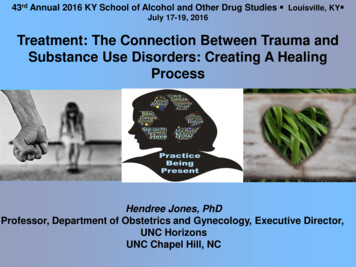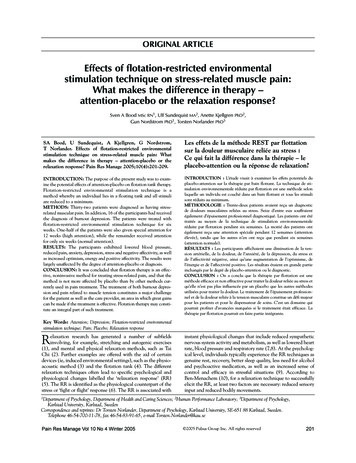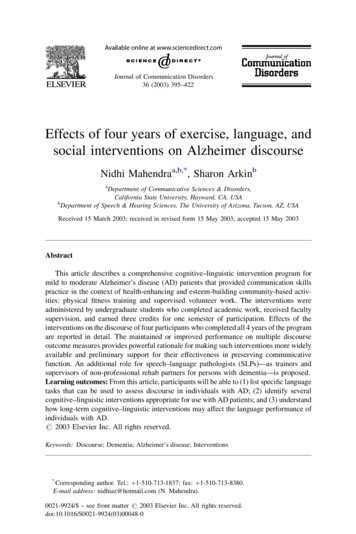
Transcription
Journal of Communication Disorders36 (2003) 395–422Effects of four years of exercise, language, andsocial interventions on Alzheimer discourseNidhi Mahendraa,b,*, Sharon ArkinbaDepartment of Communicative Sciences & Disorders,California State University, Hayward, CA, USAbDepartment of Speech & Hearing Sciences, The University of Arizona, Tucson, AZ, USAReceived 15 March 2003; received in revised form 15 May 2003; accepted 15 May 2003AbstractThis article describes a comprehensive cognitive–linguistic intervention program formild to moderate Alzheimer’s disease (AD) patients that provided communication skillspractice in the context of health-enhancing and esteem-building community-based activities: physical fitness training and supervised volunteer work. The interventions wereadministered by undergraduate students who completed academic work, received facultysupervision, and earned three credits for one semester of participation. Effects of theinterventions on the discourse of four participants who completed all 4 years of the programare reported in detail. The maintained or improved performance on multiple discourseoutcome measures provides powerful rationale for making such interventions more widelyavailable and preliminary support for their effectiveness in preserving communicativefunction. An additional role for speech–language pathologists (SLPs)—as trainers andsupervisors of non-professional rehab partners for persons with dementia—is proposed.Learning outcomes: From this article, participants will be able to (1) list specific languagetasks that can be used to assess discourse in individuals with AD; (2) identify severalcognitive–linguistic interventions appropriate for use with AD patients; and (3) understandhow long-term cognitive–linguistic interventions may affect the language performance ofindividuals with AD.# 2003 Elsevier Inc. All rights reserved.Keywords: Discourse; Dementia; Alzheimer’s disease; Interventions*Corresponding author. Tel.: þ1-510-713-1837; fax: þ1-510-713-8380.E-mail address: nidhiaz@hotmail.com (N. Mahendra).0021-9924/ – see front matter # 2003 Elsevier Inc. All rights reserved.doi:10.1016/S0021-9924(03)00048-0
396N. Mahendra, S. Arkin / Journal of Communication Disorders 36 (2003) 395–4221. IntroductionIndividuals with dementia represent the fastest growing clinical populationserved by speech–language pathologists (SLPs). It is estimated that by the year2040, approximately 14 million Americans will be afflicted with Alzheimer’sdisease (AD) or similar dementias (Evans, 1990). The breadth of their training andscope of practice qualifies SLPs to enhance the clinical management of dementiapatients through comprehensive assessment of and intervention for cognitive,communicative, and swallowing difficulties. However, despite the training andskills to provide cognitive, communicative, and swallowing assessment andintervention services, most SLPs find dysphagia evaluation and treatment servicesforming the bulk of their clinical work with dementia patients in long-term caresettings.This has occurred largely because of the insistence by Medicare on the‘‘medical necessity’’ of services provided by rehabilitation professionals inlong-term care settings. Treatment of symptoms such as aspiration risk, weightloss, malnutrition, and dysphagia fit more cleanly under the category of ‘‘medically necessary,’’ reimbursable services and thus, they are more frequentlyrequested by physicians and nurses than cognitive and communicative services.Outcomes of dysphagia therapy as compared to those of cognitive–linguistictherapy, are also more tangible (increased body weight, greater percentage ofmeal consumed, etc.), and easier to document objectively (reduced coughing, dietmodification, etc.). Unfortunately, interventions that enhance orientation,improve amount of meaningful communication, improve recall of autobiographical information, decrease frequency of disruptive vocalizations, and improveaffect and mood of dementia patients are seldom ordered by physicians.Finally, the progressive nature of AD means that treatment outcomes may belimited to maintenance of function, which is discouraging to health care professionals trained to anticipate improvement as a result of their efforts (Clark &Witte, 1991). The combined effects of these trends in reimbursement practicesand provider negativism have greatly limited the role of SLPs in serving dementiapatients in many life-enhancing areas. Bayles (2001) urges SLPs to invokeASHA’s Code of Ethics and the OBRA (Omnibus Budget Reconciliation Act,1987) mandate to focus primarily on the welfare of dementing patients and tooffer the highest quality of service so individuals with dementia may function atthe highest level possible. Clinicians need to develop new cost-effective ways todeliver a wider range of services in long-term care settings. They also need to stayabreast of empirical evidence about the efficacy and effectiveness of short-term,long-term, direct, and indirect interventions to maintain and/or improve functionand quality of life in dementia patients (e.g., Arkin, 2001; Camp, Foss, O’Hanlon,& Stevens, 1995; Clare et al., 2000; Hopper, 2001; Mahendra, 2001; Moss,Polignano, White, Minichiello, & Sunderland, 2002, and other articles in thisissue). Furthermore, clinicians need to participate in collaborative research effortsto fill gaps in the research concerning non-pharmacological interventions.
N. Mahendra, S. Arkin / Journal of Communication Disorders 36 (2003) 395–422397The Elder Rehab program developed at the University of Arizona’s Department of Speech & Hearing Sciences provides a unique model to compensate forthe limited amount and duration of direct cognitive–linguistic interventions thatMedicare allows SLPs to provide to individuals with AD. As will be shown, itfulfills all of the basic needs of persons with dementia postulated by the BASICSbiopsychosocial model (Vickers, 1974, as cited in Ronch, 1987) for dementiaenvironments and interventions: Biological, ADLs, Societal, Interpersonal, Creative, and Symbolic (Appendix A). It offers an easily-replicated system of usingstudents to administer and supervise rehab interventions. It is cost-effectivebecause the students are not paid for providing these services. Rather they paytuition for this experience and are compensated through the faculty supervision,learning and academic credits they receive. Unlike the overburdened familycaregivers of persons with dementia, students tend to be energetic, enthusiastic,optimistic, and free of the ‘‘therapeutic nihilism’’ attributed by Clark (1995) toSLPs and other professionals who deal with dementia. The role played by studentscould also be filled by paid caregivers, volunteers, and motivated family members.Though this intervention model was developed in an outpatient context, it couldbe easily adapted to skilled nursing or assisted living facility settings. The SLPcan be the catalyst who mobilizes available but untapped human and communityresources to deliver language stimulation activities for improving quality of life.In this article, we present a detailed description of the multi-component ElderRehab program and its activities, and attempt to fill the gap in the literature on theeffects of direct, longitudinal interventions on the language and discourse ofdementia patients.2. Background2.1. Volunteers in Partnership (VIP)The Elder Rehab program was an outgrowth of an earlier program—Volunteers in Partnership (Arkin, 1995, 1996). VIP paired 12 individuals with dementiawith students who supervised them in 10-weekly, 2-h sessions consistingof volunteer service or other meaningful community activity and including30–50 min of students administering structured verbal fluency and conversational stimulation. Gains in number of substantive on-topic statements producedon a discourse sample were achieved by 7 of the 12 participants. Eight participants also showed improvement in their ability to describe pictures and tointerpret proverbs.Structuring opportunities for persons with dementia to be of service to othersprovided them an important opportunity to re-connect to the community and toassume responsibilities that gave definition to their lives. Thus, the programaddressed the Societal, Interpersonal, and Creative needs areas mandated by theBASICS model. For a review of the psychosocial benefits of volunteering and
398N. Mahendra, S. Arkin / Journal of Communication Disorders 36 (2003) 395–422description of a supervised volunteer service program for early stage dementiapatients operated by an adult daycare center in Chicago, see Stansell (2002).2.2. Elder RehabThe Elder Rehab program, which was the context for the discourse studyreported here, added another normalizing and beneficial activity—physical exercise to the interventions offered in the VIP program. Physical exercise sessionstook place in a wellness/cardio rehab facility where participants interacted withmedical students, doctors, nurses, other hospital employees and patients of theUniversity of Arizona Medical Center. Memory and language stimulation activitieswere administered during workouts on a treadmill, stationary bicycle, and duringrest periods. The physical fitness activities address the Biological needs area in theBASICS model by increasing cardiovascular fitness and strength and the ADL areaby maintaining or increasing ambulation, balance, and the ability to bend, lift, risefrom a chair, lower oneself into a car, dress, and carry out household chores.3. Methods3.1. Study participantsTwenty-four mild to moderate stage AD patients, aged 54–86 years at entry,participated for 1–4 years in the Elder Rehab program between September 1997and June 2001. Their baseline Mini-Mental State Exam (MMSE) (Folstein,Fosletin, & McHugh, 1975) scores ranged from 15 to 29. The four who completedall 4 years and whose discourse performance is reported here were one man, aged59 years at entry, and three women in their eighties. See Table 1 for theirdemographic characteristics and baseline scores on the MMSE and the ArizonaBattery for Communication Disorders of Dementia (ABCD; Bayles & Tomoeda,1991). Independent sample t-tests were conducted to compare their baselineTable 1Participant demographic n 862317262920.616.718.920.912141212With spouseAssisted livingGroup homeHome aloneElectricianHomemakerSchool bus driverMobile homepark owneraAge at baseline.Mini-Mental State Exam score at baseline.cArizona Battery for Communication Disorders of Dementia score at baseline.b
N. Mahendra, S. Arkin / Journal of Communication Disorders 36 (2003) 395–422399characteristics to the other 20 participants. No significant differences were foundbetween the two groups in age, years of education, mean MMSE and ABCDscores, stage of dementia as measured by the Clinical Dementia Rating (CDR)(Berg, 1988), or number of comorbidities.Participants were diagnosed, tested, and enrolled according to criteria, procedures, and instruments used by the Consortium to Establish a Registry forAlzheimer’s Disease (CERAD; Morris et al., 1989). All met the criteria for aclinical diagnosis of Alzheimer’s disease as established by the National Instituteof Neurological and Communicative Disorders and Stroke/Alzheimer’s Diseaseand Related Disorders Association (NINCDS/ADRDA; McKhann et al., 1984).All participants passed a speech discrimination screening administered as part ofthe ABCD.3.2. Student Rehab partnersUndergraduate student participants were recruited from many different departments in response to mass emails sent to honor students, pre-health sciencemajors, and other likely groups. Eighty percent of the participants were females.Students were accepted on a first-come, first-served basis; the only requirementsbeing access to a motor vehicle, a current driver’s license, and auto insurance. TheUniversity’s Risk Management department provided liability insurance coveragesecondary to the student’s own insurance. In 4 years of student-providedtransportation and supervision of study participants, no accidents or injuriesoccurred during program activities. The students earned three independent studycredits for one semester of participation. Their responsibilities included drivingthe patient to and from program activities in their (the student’s) personal vehicle;supervising one exercise plus memory and language stimulation session, and onecommunity activity plus walking session per week for 10 weeks. Additionally,each student attended six, 2-h seminars related to dementia, exercise, and agingand received group and individual training and supervision in the administrationand recording of intervention activities.3.3. Cognitive–linguistic assessmentStudy participants were assessed at enrollment and after every two semestersof intervention with a battery of standardized cognitive and language tests, plusthe battery of discourse measures created for this study. The standardized testsused were the CERAD neuropsychological battery which includes the MMSE, a15-item short version of the Boston Naming test (BNT; Kaplan, Goodglass, &Weintraub, 1983), and a timed category fluency test; the ABCD; and the WAIS-RSimilarities and Comprehension sub-tests (Wechsler, 1981). Study participantswere also assessed by a CERAD-certified clinician according to the CDR, astructured interview protocol used by the CERAD to establish the stage ofdementia (Morris et al., 1989).
400N. Mahendra, S. Arkin / Journal of Communication Disorders 36 (2003) 395–4223.4. Discourse outcome measuresThe discourse battery used to monitor language performance of Elder Rehabparticipants had three parts: (a) eight stimulus prompts or questions on a variety oftopics relevant to mature adults, (b) a five-item proverb interpretation (PI) task,and (c) a picture description task. The tasks were selected to elicit the fivedifferent discourse types described by Shadden (1995). (For a detailed discussionof the rationale for each component, see Arkin & Mahendra, 2001a.)(A) Eight stimulus prompts:1. Tell me what you know about John F. Kennedy and his family.2. Tell me what you know about Alzheimer’s disease.3. This was used to assess insight as well as discourse (Arkin &Mahendra, 2001b, in press).4. Tell me about your daily activities, the things you do every day.5. Tell me about the things you do once in a while, not every day.Prompts 3 and 4 assessed participant discourse and level of awarenessabout their current life.6. Tell me the childhood thoughts and memories the word ‘‘play’’reminds you of.7. Tell me the adult thoughts and memories the word ‘‘play’’ remindsyou of.8. How would you go about planning a picnic for your family or somefriends?9. Supposing the 13-year-old daughter of a neighbor told you she waspregnant, but was afraid to tell her mother. What would you do? Whatare some of the ways the family could handle that situation? Thesecond part of Prompt 8 was designed to see how many solutionsrespondents could suggest for the presented situation.Responses to these prompts were audio and videotaped, and transcribed by students. Transcripts were demarcated into utterances andcoded, according to procedures previously described (Arkin & Mahendra, 2001a). Responses to each prompt were scored in terms of: (a) totalutterances; (b) topic comments (complete, content-filled, non-ambiguous, ‘‘non-empty’’ statements relevant to the topic under discussion);(c) neutral utterances; (d) negative utterances (e.g., confabulations,repetitions, incomplete thoughts, meaning unclear statements); (e) totalnouns; (f) different nouns; and (g) vague nouns (e.g., stuff, thing). Ratioswere computed to determine percentage of positive and negative utterances and different noun types relative to total utterances. High interand intra-scorer agreement ( 80%) on utterance demarcation, classification, and noun counts was established after extensive training anddiscussion on instances of disagreement (see Arkin & Mahendra, 2001afor details).
N. Mahendra, S. Arkin / Journal of Communication Disorders 36 (2003) 395–422401(B) Five-item proverb interpretation task: The five-item proverb interpretation task was adapted from Delis, Kramer, and Kaplan (1984). The fiveproverb stimuli used were:1. They see eye to eye.2. Too many cooks spoil the broth.3. Rome wasn’t built in a day.4. Don’t count your chickens before they hatch.5. You can’t tell a book by its cover.Participant responses were scored along a seven-point concreteness–abstractness continuum (Chapman et al., 1997—Appendix B) with 6being a complete abstract response and 0 being an incorrect or noresponse. The highest possible score on the test was 30 (5 items 6points). To ensure reliability of scoring, baseline and first year postintervention transcripts were scored by Chapman and colleagues, usingtheir guidelines (Chapman et al., 1997). At the end of the first year, thesecond author scored all patient responses, following Chapman’s guidelines and consulting with her on questionable responses. Intra-scoreragreement was obtained after re-scoring 25% of participant transcriptsand determining item-by-item reliability to be 75%.(C) Grocery store picture description: This task is from the AphasiaDiagnostic Profiles (ADP; Helm-Estabrooks, 1992). Participants wereasked to describe the picture in as much detail as possible and when theystopped, they were encouraged to provide more information by use ofgeneral prompts such as ‘‘Is there anything else you can tell me aboutthis picture?’’ Descriptive discourse elicited was scored according tothe guidelines and list of acceptable sample information units providedin the ADP manual. Prepositional phrases, multiple verb forms, aswell as pronouns relating to a new topic (personal communication,Helm-Estabrooks, 1997) were also given credit.4. InterventionsStudent participants administered one 2–2.5-h exercise plus language stimulation session, and supervised one 1.5–2-h community activity session per week for10 weeks per semester. A family member supervised 10 weekly exercise sessions.4.1. Physical fitnessThe physical fitness intervention that provided the context for the language andmemory stimulation activities consisted of a treadmill and stationary bicycleworkout, strength training on five machines, and flexibility and balance exercises.Details and outcomes have been described elsewhere (Arkin, 1999, in press).
402N. Mahendra, S. Arkin / Journal of Communication Disorders 36 (2003) 395–4224.2. Community activity sessionsSessions alternated between supervised volunteer service at communityagencies and cultural or recreational activities (Arkin, 2001). Students wereinstructed to incorporate 20 min of walking into the community activity sessions,to bring the frequency of aerobic activity to the usually recommended three timesper week.4.3. Cognitive–linguistic activitiesThe portfolio of language activities provided practice in the importantcognitive operations identified by Orange and Purves (1996) as relevant toconversational performance. Each activity and the cognitive process/es it tappedinto are listed below. Students were instructed and repeatedly reminded to usethese exercises as a launchpad for dialogue between them and their partners, notsimply to record a first response and quickly move on. Each activity was labeledeither ‘‘during’’ or ‘‘rest’’ to indicate whether it was to be administered during anaerobic activity or during a rest period. Tasks requiring concentration or deepprocessing were reserved for rest periods. All activities required participants tomaintain attention to the task and to perform some form of deep processing (Craik& Lockhart, 1972) in response to a presented stimulus and to produce verbalresponses. A complete list, brief description, and examples of language activitiesused in the Elder Rehab program are presented in Table 2. Nine or 10 were usedduring any given semester. Language session report booklets containing participant responses to the various activities were turned in weekly by the students.Record cards containing aerobic and strength training achievements were alsocompleted for each session.5. ResultsThe effects of the interventions on the four participants’ performance onpreviously listed discourse outcome measures are reported below.5.1. Topic comment to total utterance (TC/U) ratioBecause our interest was in increasing appropriate and on-topic verbalutterances, the chief outcome measure was a ratio of topic comments to totalutterances. These data are presented in Fig. 1. Most noteworthy is that two of thefour (S1 and S4) participants improved their ratios from baseline to year 4. S1’simprovement was modest and consistent, except for a leveling off between years 3and 4. S4’s was erratic, with substantial dips in years 2 and 3 and a dramaticincrease in year 4. The two non-improvers (S2 and S3) also showed declines intheir second and third years, but S2 again showed improvement in her fourth year.
N. Mahendra, S. Arkin / Journal of Communication Disorders 36 (2003) 395–422403Table 2Language activities used in the Elder Rehab programPicture descriptionRequires attention, visual scanning, naming, narrative discourse production,and processing of literal and interpretive concepts in the picture (e.g., in theGrocery store picture task, a literal concept is ‘‘a child spilling eggs’’ and aninterpretive concept is ‘‘no one is paying attention to the child’’). Advantagesof picture description tasks for persons with dementia are that this does notinvolve memory and concepts missed can be pointed out by directing theparticipants’ attention to the details or contextual cues in the picture. Theprogram’s use of this activity differed from the use of picture description asan assessment instrument, when only non-specific cues are given. Thisactivity typically took place at the beginning of the session. A NormanRockwell was presented. Students would prompt: ‘‘Tell me what you see inthat picture—what’s going on?’’ After recording the free response, studentsasked questions (from a prepared list in a resource manual) designed tofocus attention on details and relationships and to elicit inferences frompictorial cuesCar bingoRequires orientation, attention, reading words and short phrases, visuospatialscanning (to search for objects), and procedural memory for what a ‘‘bingo’’activity involves. This activity occurred during the car ride to and from theintervention site. A large bingo-type card was prepared, each squarecontaining the name of an object that might be seen from a car window (e.g.,red pickup truck, driver wearing a hat, dead animal, school bus). Participantswere challenged to look for one or more items at a time during a given trip,depending on their ability to focus on more than one item at a time. The dateon which an item was observed was written on the card’s appropriate squareObject descriptionUtilizes lexical and semantic memory and requires an individual to generatemeaningful attributes of a common object. Three objects (lemon, pencil,toothbrush) were presented in order and participants were asked to describethem. Based on the spontaneous response, prompt questions were asked toelicit additional informationStory recallwith quizThis activity employs a fixed interval type of spaced retrieval (Camp et al.,1995) and challenges participants’ explicit and episodic memory. The formatis similar to that used in a series of successful autobiographical memorytraining studies with Alzheimer patients (Arkin, 1992, 1997, 1998, 2000).Students read a brief story containing six–seven facts and asked partners tore-tell the story immediately after presentation. Students then re-read story,posing a question about each fact after it was stated, pausing for the partnerto answer, if able, then giving the correct answer. Students then repeated allsix questions and solicited their partner’s answers, giving the correct one if s/he failed to answer correctly. The partner was then asked to re-tell the story.When five out of six questions were answered correctly and the partnerspontaneously recalled four major facts about the story, a new story wasintroduced for the following session. Topics of stories were adult in contentand emotionally charged (see Appendix C for an example)
404N. Mahendra, S. Arkin / Journal of Communication Disorders 36 (2003) 395–422Table 2 (Continued )Category fluencynaming-quizUtilizes the relatively preserved implicit memory systems of AD patients(Bäckman, 1992; Camp et al., 1995) and fosters production of non-studiednovel exemplars through the process of spreading activation (Bayles &Kaszniak, 1987; Collins & Loftus, 1975). A 60-s category fluency test wasadministered (e.g., things people wear) 18–20 times in a given semester,typically before and after each exercise session. A master (baseline) list of allthe different exemplars ever named by each participant during those tests wascompiled. The subsequent semester, participants were presented with a 40- to50-item study task at the start of their exercise session. Pictures of items fromthe subject category were alternated with questions about the same topic(e.g., What might a woman wear to bed instead of pajamas?). Correctanswers were supplied. At the end of the exercise session, the categoryfluency test was given again. Lists produced following exposure to studytasks were analyzed for (a) words never named at baseline, but that were onthe study task—evidence for implicit learning; and (b) novel words, i.e.,words never named at baseline and that were not on the study task—evidenceof spreading activation. Results obtained for the clothing category on thistask are published elsewhere (Arkin, Rose, & Hopper, 2000)Opinion andadvice questionsRequires participants to use logical thinking, reasoning, and moral judgment.A situation involving a moral issue or personal values is presented toparticipants and their opinion solicited. Probe questions were asked afterrecording an initial, spontaneous response. Controversial adult topics anddilemmas were presented. For example, ‘‘Would you help a terminally illfriend hide pills he was accumulating in order to commit suicide?’’ Thisactivity was successfully used in a geropsychiatric hospital in Germany tocounteract loss of social roles and functions that accompanies institutionalization (Muller, 1993)Pros and consEnables participants to practice reasoning skills. Participants were given aseries of topics or objects and were asked to tell what was good and bad abouteach one. Students used topics and responses as a springboard for conversation,sharing their opinions during the dialogue. For example, retirement, cellphones, etc.Problem solvingFocuses on participants’ critical thinking and reasoning skills. One of aseries of picture cards developed for use with adults with disabilities (Pitti &Meier, 1992) was presented at each session. Each card depicts a dailyliving situation in which a problematic or dangerous element is present. Forexample, a depicted situation might include someone reaching into an ovenwith bare handsA my nameis . . . gameProvides practice in generative naming, set shifting, and executive functionskills. Students read the framework phrase and asked participants to producean appropriate word (man’s/woman’s name, place name, etc.) beginning withand my (wife’s) namethe target letter for each blank (A my name isisand we come fromand we’re going downtown to buy;B, etc.). Higher functioning participants were asked to advancemy name isthrough the alphabet with each word produced (e.g., A: Alice, B: Bob,C: Chicago, etc.)
N. Mahendra, S. Arkin / Journal of Communication Disorders 36 (2003) 395–422405Table 2 (Continued )SimilaritiesTargets abstract reasoning skills and is similar to that tested by the WAIS-Rsubtest. Pairs of words belonging to the same superordinate category werepresented and participants were asked to name the category. They were askedwhat the two words in each pair of items had in common—how they werealike. If they named an attribute or a function, they were corrected and toldthe correct category name and were asked to repeat it. For example, Cup andplate(both dishes) (not, ‘‘you eat from both’’)Proverb completionand interpretationEngages abstract verbal reasoning (Lezak, 1995) and higher order cognitiveprocesses of figurative language comprehension (Van Lancker, 1990).Students read beginnings of proverbs to see if participants knew the ending.If not, students gave the ending. Then students asked participants what theproverb meant. If participants gave a concrete or incorrect response, studentsgave the abstract interpretation. Then proverbs were read again andparticipants asked again for their interpretation. For example, A bird in the(is worth two in the bush). Proverbs and their interpretationshandwere taken from The Dictionary of Cultural Literacy (Hirsch, Kett, & Trefil,1988). This activity was difficult for many patients, and some students. Aneasier, often more successful variant was to read beginning lines of a list ofproverbs and have subjects provide endings. After a few times, participantstypically learned the correct responsesFamous namesStimulates recognition memory for the names of famous people. Participantswere read a series of first names of famous people and were asked to providetheir last names. Students asked participants if they could tell somethingabout that person. Identifying information for most commonly namedindividuals was supplied to the students, as they frequently did not know whosome of the famous individuals were. This was an area where participantscould often educate their student partnersWord associationProvides information on lexical–semantic organization by triggering retrievalof concepts and ideas related to a target stimulus. Participants were enc
supervisors of non-professional rehab partners for persons with dementia—is proposed. . ASHA's Code of Ethics and the OBRA (Omnibus Budget Reconciliation Act, . and auto insurance. The University's Risk Management department provided liability insurance coverage secondary to the student's own insurance. In 4 years of student-provided



